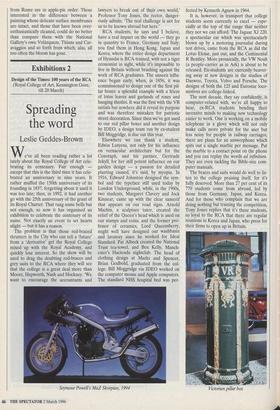Exhibitions 2
Design of the Times: 100 years of the RCA (Royal College of Art, Kensington Gore, till 20 March)
Spreading the word
Leslie Geddes-Brown
We've all been reading rather a lot lately about the Royal College of Art cele- brating its centenary. Fair enough except that this is the third time it has cele- brated an anniversary in nine years. It rather muffed the 150th anniversary of its founding in 1837, forgetting about it until it was too late; then, in 1992, it had another go with the 25th anniversary of the grant of its Royal Charter. That rang some bells but not enough, so now it has organised an exhibition to celebrate the centenary of its name. Not exactly an event to set hearts alight — but it has a reason.
The problem is that those red-braced thrusters in the City who can tell a 'future' from a 'derivative' get the Royal College mixed up with the Royal Academy, and quickly lose interest. So the show will be used to drag the doubting red-braces and grey suits to the RCA where they will see that the college is a great deal more than Moore, Hepworth, Nash and Hockney. 'We want to encourage the accountants and lawyers to break out of their own world,' Professor Tony Jones, the rector, danger- ously admits. 'The real challenge is not for us to be known abroad but here.'
RCA students, he says and I believe, have a real impact on the world — they go in quantity to France, Germany and Italy; you find them in Hong Kong, Japan and Korea, where the entire design department of Hyundai is RCA-trained, with not a tiger economist in sight, while it's impossible to live in Britain without brushing against the work of RCA graduates. The unseen influ- ence began early, when, in 1856, it was commissioned to design one of the first pil- lar boxes: a splendid example with a frieze of lotus leaves and garlands of roses and hanging thistles. It was the first with the VR initials but nowhere did it reveal its purpose and was therefore mistaken for patriotic street decoration. Since then we've got used to our red pillar boxes and another design by IDEO, a design team run by ex-student Bill Moggridge, is due out this year.
Elsewhere we can thank a student, Edwin Lutyens, not only for his influence on vernacular architecture but for the Cenotaph, and his partner, Gertrude Jekyll, for her still potent influence on our garden design — a passion for detailed planting caused, it's said, by myopia. In 1916, Edward Johnston designed the sym- bol and the typeface still used today by London Underground, while, in the 1960s, two students, Margaret Clavery and Jock Kinnear, came up with the clear sanserif that appears on our road signs. Arnold Machin, a sculpture tutor, created the relief of the Queen's head which is used on our stamps and coins, and the former pro- fessor of ceramics, Lord Queensberry, might well have designed our washbasin and lavatory since he worked for Ideal Standard. Pat Albeck created the National Trust tea-towel, and Ben Kelly, Manch- ester's Hacienda nightclub. The head of clothing design at Marks and Spencer, Brian Godbold, graduated from the col- lege. Bill Moggridge via IDEO worked on the computer mouse and Apple computers. The standard NHS hospital bed was per- Seymour Powell's MuZ Skorpian, 1994 fected by Kenneth Agnew in 1964.
It is, however, in transport that college students seem currently to excel — espe- cially at the top of the range that neither they nor we can afford. The Jaguar XJ 220, a spectacular car which was spectacularly blown up by a motoring journalist during test drives, came from the RCA as did the Lotus Eloise, just out, and the Continental R Bentley. More prosaically, the VW Noah (a people-carrier as in Ark) is about to be released. Ex-students are currently beaver- ing away at new designs in the studios of Daewoo, Toyota, Volvo and Porsche. The designs of both the 125 and Eurostar loco- motives are college-linked.
The next decade, they say confidently, is computer-related with, we're all happy to hear, ex-RCA students bending their inventive minds to making new technology easier to work. One is working on a mobile telephone in a glove which will not only make calls more private for the user but less noisy for people in railway carriages; there are plans for an answerphone which spits out a single marble per message. Put the marble to a contact point on the phone and you can replay the words ad infinitum. They are even tackling the Bible-size com- puter manuals.
The braces and suits would do well to lis- ten to the college praising itself, for it's fully deserved. More than 27 per cent of its 770 students come from abroad, led by those from Germany, Japan, and Korea. And for those who complain that we are doing nothing but training the competition, Tony Jones replies that it's these students, so loyal to the RCA that there are regular reunions in Korea and Japan, who press for their firms to open up in Britain.
Victorian pillar box


































































 Previous page
Previous page